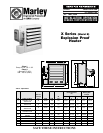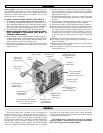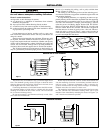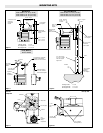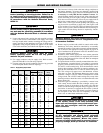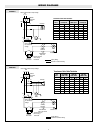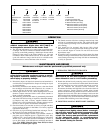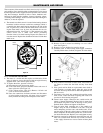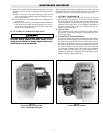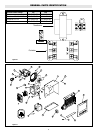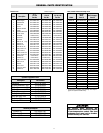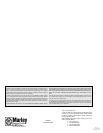
2
Read Carefully - These instructions are written to help you pre-
vent difficulties that might arise during installation of heaters.
Studying the instructions first may save you considerable time and
money later. Observe the following procedures, and cut your
installation time to a minimum.
TO REDUCE RISK OF FIRE AND ELECTRIC SHOCK:
1. To reduce the risk of ignition of hazardous atmospheres:
In accordance with the National Electrical Code, do not install
where operating temperature code exceeds the ignition temper-
ature of the hazardous atmosphere. Use only in atmospheres
having an ignition temperature higher than 165°C (329°F).
2. Disconnect from supply circuit before opening enclosures.
3. Hazard of Electric Shock. Heater must be effec-
tively grounded in accordance with N.E.C. to
eliminate shock hazard.
4. Heat exchanger contains Propylene Glycol under pressure at
operating temperature. A material safety data sheet (MSDS) is
available from Marley upon request. Should leakage occur,
remove unit from service and investigate cause.
5. Keep all electrical enclosure covers tightly closed and secured
with all bolts and threads. Cover joints must be clean before
replacing covers.
6. Install and operate in upright position only. Refer to Figure 3
for level requirements. Failure to comply will cause overheat-
ing of the element and shutting down the unit by tripping the
high temperature cutout.
7. All unused threaded openings not used for supply wiring must
be fitted with threaded plugs approved for use in hazardous
locations.
8. All unit electrical installation fittings, conduit, wiring and seals
must meet NEC and local codes for hazardous locations.
9. External line fusing or circuit breaker protection is required.
10. Hi limit cutouts must never be bypassed in the control circuit.
11. Alarm pilot lamp, if supplied, will turn on if the high limit con-
trol actuates. Steady on lamp indicates manual reset protector
has tripped. This could result if the heat exchanger is obstruct-
ed (dirty), inlet air restricted or fan not turning. Shut off power
to unit and refer to repair procedures section of instruction
sheet.
12. Mounting clearances on nameplate must be observed.
13. Use copper wire for supply connections according to size and
rating on nameplate.
14. Do not install any type of gasket material on any of the electri-
cal junction box cover surfaces.
15. Do not attempt to override louver stops or operate unit with
louvers fully closed.
GENERAL
The X-Series units rated 3 through 35 kW are designed for
operation in Class I, Div. 1, Group C & D and Class II, Div. 1,
Groups E, F and G hazardous atmospheres having an ignition tem-
perature of 165°C (329°F) or higher. They are designed for com-
fort heating and should not be operated in ambient temperatures
exceeding 40° (104°F). All units in Table A are UL listed. The
units are easily adapted for wall, ceiling or pole mounting. Refer
to Figure 4 on Page 3 for mounting information. They are supplied
with either 24 or 120V internal control circuit voltage. The heater
is designed for use with an external hazardous location thermostat
or optional built-in thermostat.
The standard heater is designed to operate up to 7500 feet
(2286 m) altitude. Consult factory for specific recommenda-
tions when using the units at higher altitudes.
Heavy gauge adjustable
louver with minimum
opening stops - to direct air flow
Removable front cover
for ease of cleaning
High efficiency heat exchang-
er with integral
aluminum-finned steel tubes
Optional service light to
indicate when unit
needs servicing
Built-in 120V control cir-
cuit transformer
(Optional 24V available)
Heavy duty immersion heater assembly
with manual reset limit control and NEMA
7 and 9 terminal enclosure
Protective housing for
immersion heater ter-
minal enclosure
Convenient terminal
block for room
thermostat connection
Motor connections
wiring access
Explosion-proof
(NEMA 7 and 9)
controls enclosure
Integral, heavy duty
magnetic contactor
Explosion
proof motor
Mounting bolt hang-
er connections
Polyester powder-coated
heavy gauge steel corrosion
resistant cabinet
Overpressure
protection device



